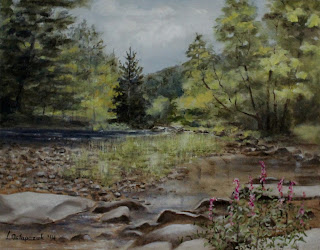Morrell’s: With
little doubt this run on the Rondout Creek, immediately upstream of the UC 42
bridge over the headwater brook near the former Morrell Field, is one of this
angler’s favorite piscatorial settings.
History can be seen in the remains of old stone abutments while the
brook runs as clear today as it ever did.
Plus, not far from here the iconic Catskill flyfisher, Edward Ringwood
Hewitt, noted the difficulties associated with catching wild brook trout in the
legendary Blue Hole when he shared his angling secrets in Telling on the Trout.
Morrell’s,
8x10:
This
landscape was painted before from a different photograph and titled:
Above Morrell Field, 11x14:
Above Morrell Field, 11x14:




